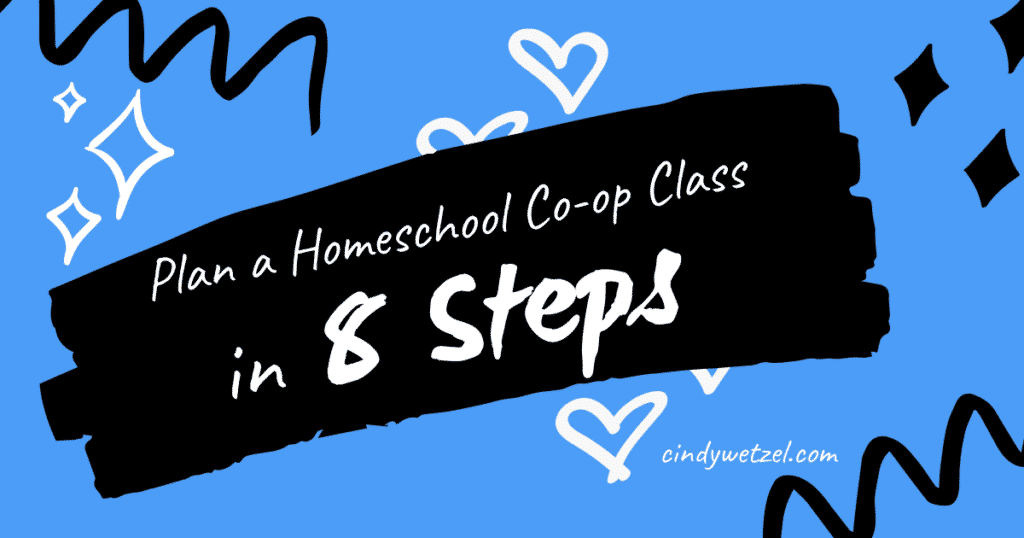If you’re part of a homeschool group or co-op, you may be asked to teach a class.
Don’t panic! With a little planning and prep work, you can easily teach many co-op classes.
Good News: Each time you teach a homeschool co-op class, it gets easier. That means you’ll soon be a pro!

I started teaching classes at our homeschool group when we first started homeschooling.
Those first classes were challenging because I didn’t know what to expect. There also weren’t very many online resources for teaching homeschool co-op classes.

Five years later, thanks to the experienced homeschool moms in our group, I’m feeling pretty comfortable with lesson planning and teaching.
Table of Contents
How to Plan a Homeschool Co-op Class from Scratch
The eight steps I use to plan a homeschool co-op class.
- Make a long list of topics
- What are you good at?
- What do you enjoy doing (hobby, work)?
- What do you talk about all the time?
- What would you like to learn more about?
- What are your children interested in?
- What do your children need to learn about?
2. Choose a couple of topics from your list and do a little research
- Is this a realistic option?
Example: I’d love to teach some computer classes (coding, web design, beginning blogging), but our homeschool group doesn’t currently have access to multiple computers and high-speed internet.
- Will this class be affordable?
- Free classes are the favorites at our campus.
- Our group offers classes that are $10 or less. So if the materials will be more than $10, I’d be responsible for the additional cost.
- Do you have time for this class?
- How much time do you need to prepare for this class? Beware of time thieves! I once helped with a preschool class that required weekly crafts to be cut out.
- Will you have enough time in class to complete projects? Consider several small projects instead of one large project.
3. Brainstorm with your chosen topic–get all your ideas on paper. It’s ok to be messy!
- Vocabulary
- Skills
- Projects
- Resources
- Safety Procedures
- for classes using knives, ovens, scissors, chemicals, etc.
- Supplies
- What do students need to bring?
- What will you provide (use this to determine the cost)?
- Do you need access to the kitchen, gym, or outdoor space?
- Final Presentation
- Our homeschool group has a presentation night. Each class has a display or demonstration for the group (song, skit, experiment, projects on display).
4. Plan your class time. Don’t worry about making this perfect. You can adjust it at any time.
- Opening
- Attendance
- Review
- Last week, we…
- Intro
- This week, we will
- Lesson Time
- What will you do each week?
- Use your topic and brainstorm list
- Keep your lesson simple and consistent each week
- Show it, Explain It, and Try It
- One step at a time
- What will you do each week?
- Wrap It Up
- Clean-up
- Time-Fillers (for those extra minutes at the end of class)
- Game
- Trivia
- Chat
Sample Homeschool Co-op Class for Gym
5. Give your class a fun title and write a simple description.
- This will give students and parents an idea of what your class will be like
- Be sure to include:
- Age
- Our homeschool group has specific age categories, so check with yours.
- Price
- Check with your homeschool group. Our classes can’t be more than $10.
- Prerequisites
- Do they need prior knowledge? Like Spanish 1?
- Materials
- What do students need to bring to class?
- Class Limit
- How many students may take this class at one time? Check with your homeschool group.There may already be a set number.
- Age
- Be sure to include:
6. Gather and organize the materials you’ll need to teach your class.
- Shop around for the best prices
- Order early (having all your materials before you start teaching the class is ideal)
- Divide materials into folders or boxes
- Label week 1, week 2, etc…
- List materials you still need to get on each folder/box.
7. Prepare for your class
- Make samples of projects
- Try the experiments to make sure they work
- Create forms and worksheets (if needed)
- Don’t want to create your own? Try Teachers Pay Teachers (grab a freebie in my store).
- Prepare visuals (if needed)
- Posters
- Slideshow
8. Teach with confidence. You’ve got this!
- Be early to class. This gives you time to set up and not be rushed.
- My college professor repeatedly said, “If you’re on time, you’re late!”
- Be flexible.
- You may not have time for everything you’ve planned. Save it
- Something may be missing or not work. That’s ok. Skip it
- Have fun.
- If you enjoy the class, chances are good that your students will too.
- Don’t be too serious!
Plan Your Homeschool Co-op Class
Now it’s your turn!
Grab a friend and plan a homeschool co-op class in 8 brutally simple steps.
Share & Help Your Friends With Their Lesson Planning
Look at this Lesson Plan
Need another lesson example? Check out my lesson plan for homeschool gym.
This lesson plan shows how I break my classes into consistent chunks. Every week has the same plan, just new information.
